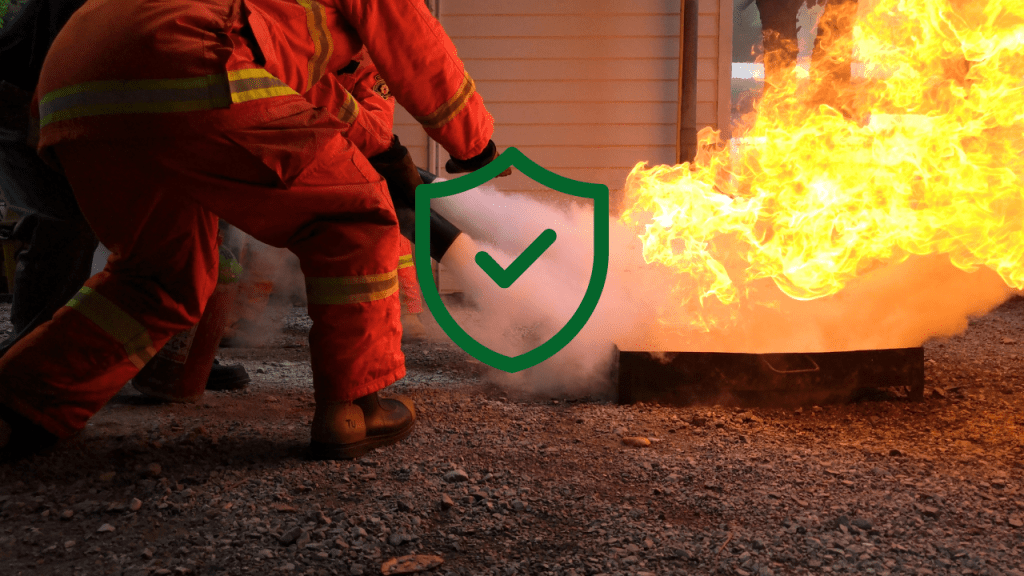As a fire safety professional, I understand the skepticism that might arise when pondering the purpose of a Fire Risk Assessment. But, let me assure you, this process goes beyond mere compliance; it serves as a critical preventive measure that safeguards lives and properties.

The intricacies of a Fire Risk Assessment may surprise you, revealing invaluable insights into fire safety practices and preparedness. Let’s explore how this assessment method not only identifies risks but also paves the way for effective risk management strategies that could mean the difference between safety and disaster.
Understanding Fire Risk Assessments
In conducting a Fire Risk Assessment, the primary objective is to thoroughly review a building to assess fire risk factors and provide actionable safety recommendations. Risk evaluation is crucial in identifying potential hazards, such as electrical equipment, flammable materials, and poor housekeeping practices.
Hazard identification involves pinpointing sources of ignition, fuel, and vulnerable individuals within the premises. Safety recommendations aim to evaluate and mitigate fire risks through measures like detection systems, escape routes, and safety equipment.
Emergency planning is essential for preparing for potential fire incidents, which includes creating evacuation plans, providing training, and ensuring clear communication of emergency procedures. Compliance assurance ensures that the assessment aligns with legal requirements, such as the Regulatory Reform (Fire Safety) Order 2005, and that necessary actions are taken to meet safety standards and prevent fire hazards.
Conducting a Fire Risk Assessment
Conducting a Fire Risk Assessment involves systematically evaluating a building to identify and mitigate potential fire hazards. Risk identification is the initial step, focusing on recognizing fire hazards following the fire triangle concept.
Safety evaluation follows, assessing the vulnerability of individuals in the building, including staff, visitors, and customers. Emergency planning is crucial, involving the formulation of effective evacuation strategies and procedures.
Compliance assurance ensures adherence to legal requirements, guaranteeing that the assessment meets necessary standards. Lastly, hazard mitigation aims to remove or minimize risks by addressing identified hazards promptly.
Legal Requirements for Fire Assessments

Upon systematically evaluating a building to identify and mitigate potential fire hazards, it’s imperative to understand the legal requirements for conducting Fire Risk Assessments. Compliance enforcement is governed by the Regulatory Reform (Fire Safety) Order 2005 in England and Wales, mandating regular assessments. Non-compliance can lead to severe legal consequences, including fines or prison sentences.
Assessment documentation is a crucial aspect, especially for buildings with five or more regular occupants, where findings and required actions must be recorded. Regular review of assessments is essential, particularly after significant changes in building layout, purpose, or occupants, to ensure compliance with regulatory obligations.
The frequency of assessments is determined by the dynamic nature of the building and its occupancy, emphasizing the need for a proactive approach to fire safety. By adhering to these legal guidelines, organizations can’t only meet their obligations but also create a safer environment for occupants.
Importance of Fire Safety Training
Emphasizing the critical role of fire safety training in enhancing workplace safety and preparedness can’t be overstated. Practical drills are essential for familiarizing personnel with emergency response procedures and safety protocols.
Conducting regular evacuation procedures reinforces preparedness and ensures a swift and organized response in case of a fire emergency. Training sessions focus on risk mitigation strategies, equipping individuals with the necessary skills to identify potential hazards and take proactive measures to prevent fires.
By engaging in hands-on exercises and simulations, employees develop the confidence and competence needed to address fire risks effectively. Emphasizing the importance of ongoing training and skill development is crucial to maintaining a high level of readiness and ensuring a safe working environment.
Implementing a comprehensive training program not only enhances individual competencies but also fosters a culture of safety consciousness within the organization.
Ongoing Fire Safety Measures
In exploring ongoing fire safety measures, the focus shifts towards the continuous evaluation and enhancement of fire prevention strategies within the workplace environment. Emergency drills play a critical role in ensuring preparedness and response efficiency during fire incidents. Regularly practicing evacuation procedures and incident response protocols helps in refining the team’s reactions and minimizing potential risks.
Safety protocols must be constantly updated to align with the latest standards and technologies, ensuring optimal risk mitigation. By conducting periodic fire safety reviews, facilities can identify new hazards and adapt their strategies accordingly.
It’s imperative to ensure staff awareness of fire safety protocols through consistent training and communication. Moreover, utilizing gathered information from assessments and incidents enables tailored approaches for specific situations. Continuous improvement in fire safety practices, along with the diligent implementation of safety measures, is essential for creating a secure workplace environment.
Frequently Asked Questions
Can a Fire Risk Assessment Be Conducted by Someone Who Is Not a Professional in the Field of Fire Safety?
Yes, a DIY assessment can be done by non-professionals with proper training. Utilizing online resources aids in understanding legal requirements. Misconceptions include assuming only experts can assess. Legal implications stress accuracy.
What Are the Potential Consequences for Failing to Comply With Legal Requirements for Fire Risk Assessments?
Failing to comply with legal requirements for fire risk assessments poses severe consequences, including potential fines or prison sentences. Non-compliance risks compromising safety measures, violating regulatory requirements, and necessitating a thorough consequences assessment for corrective actions and future compliance.
How Can Technological Advancements, Such as Fire Detection Systems, Impact the Effectiveness of a Fire Risk Assessment?
Integrating advanced fire detection systems enhances risk mitigation through real-time data analysis. Technology aids in proactive prevention strategies, optimizing emergency response. Automation improves safety protocols, streamlines compliance, and enables efficient incident management for continuous improvement in fire safety practices.
Are There Specific Industry Regulations or Standards That Businesses Need to Follow When Conducting Fire Risk Assessments?
When conducting fire risk assessments, regulatory compliance, safety measures, risk mitigation, industry standards, and training requirements are vital. Following industry guidelines ensures a thorough assessment, effective safety strategies, and proper training for staff, enhancing overall fire safety.
How Often Should a Fire Risk Assessment Be Reviewed and Updated to Ensure Its Accuracy and Effectiveness?
To ensure accuracy and effectiveness, fire risk assessments should be reviewed and updated annually. It’s vital for compliance checks, training requirements, and monitoring progress. Frequency of updates guarantees alignment with evolving safety standards and practices.
Conclusion
In conclusion, Fire Risk Assessments play a critical role in identifying potential fire hazards, assessing safety measures, and devising strategies to mitigate risks.
By conducting thorough assessments and adhering to legal requirements, we can enhance overall safety, prevent injuries, and protect lives and properties.
It’s imperative to prioritize ongoing fire safety measures and training to ensure the well-being of individuals and the maintenance of a safe environment.









